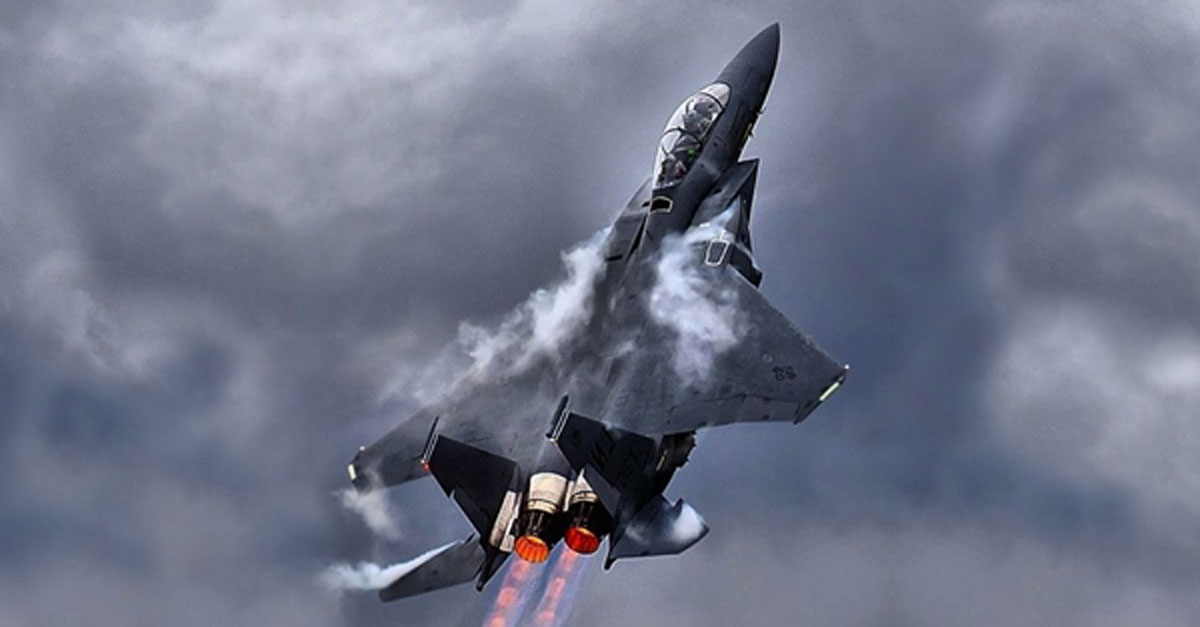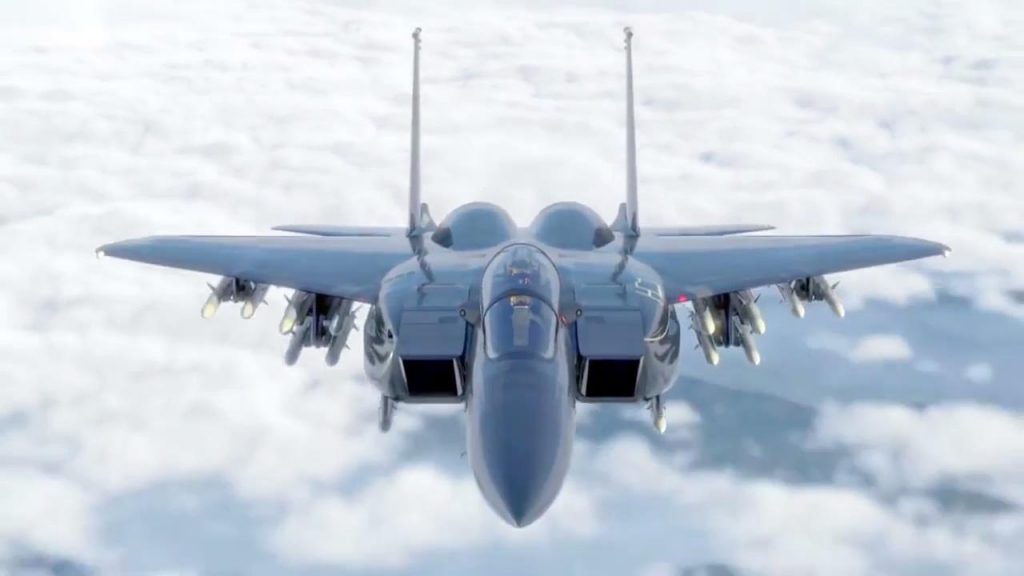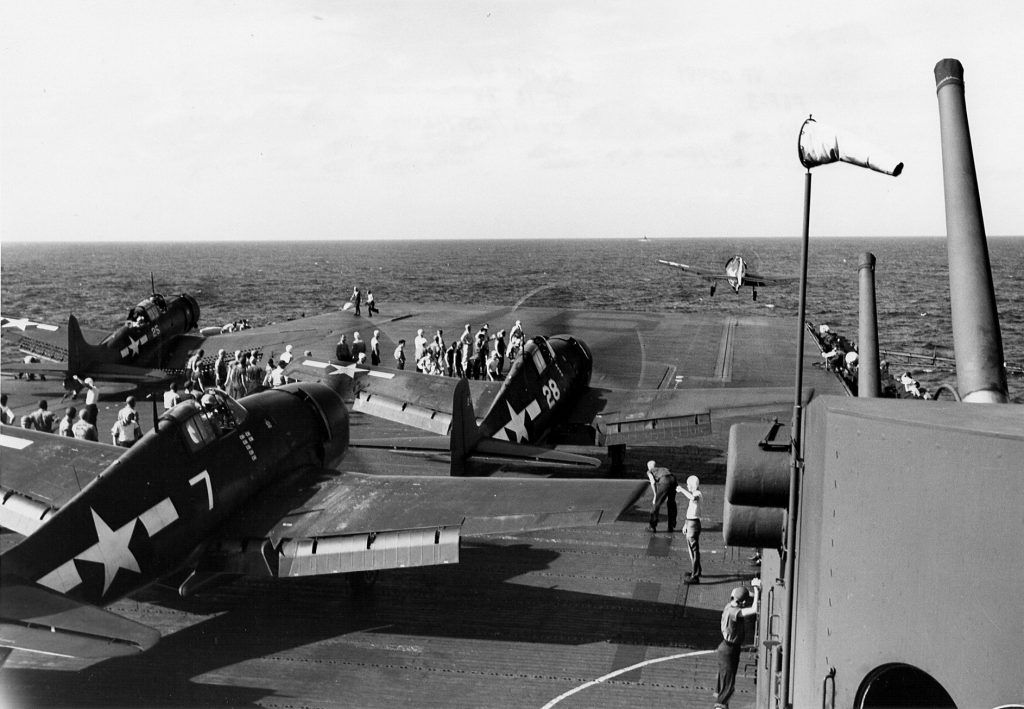
Amazing
The Most Awestriking, Devastating Military Planes Ever
Combat military planes, also called warplanes. are operated by the army to destroy enemy forces. Fighter aircraft, bomber aircraft, attack aircraft, electronic war aircraft, maritime patrol aircraft and multi-role combat aircraft are broad categories of warplanes. In this article we look at some of the most devastating military aircraft of all time.

reddit.com
1. Boeing (McDonnell Douglas) F-15 Eagle
This multi-role fighter aircraft entered the military service in 1976 and overtime became a classic American warplane having a great combat record. The Boeing F-15 Eagle is still in service as of 2018 and is operated by the United States, Japan, Saudi Arabia, Israel, Qatar, South Korea and Singapore.The aircraft can accommodate 1 or 2 crew members and can travel at a speed of 3017 kilometers per hour/1,875 miles per hour.

reddit.com
The McDonnell Douglas F-15 Eagle series was made to replace the McDonnell F-4 Phantom II series that was used during the Vietnam War, by being designed with advanced technologies and would advance to have an superior kill-to-loss record. Model Variants of this superior aircraft series include the F-15A, F-15B, F-15C, F-15D, F-15E, F-15SA, TF-15A, F-15J and so on. Standard armor for the F-15 Eagle series includes internal cannon used in close-combat, laser guided bombs for ground attack, missiles and drop bombs.

reddit.com
2. Focke-Wulf Fw 190 (Wurger)
This single-seat fighter-bomber aircraft is considered the greatest German warplane of the 2nd World War. It was created in 1941 by Fock-Wulf Nazi Germany. 20,000 planes of this type were produced, but this plane is no longer in service. It was operated by Nazi Germany, Czechoslovakia, Hungary, France, Romania, Turkey, Imperial Japan, Spain and Yugoslavia. The Fw 190 accommodated 1 crew member and had a maximum speed of 685 kilometers per hour/26 miles per hour.

reddit.com
The standard armament was made up of MG 131 2x13mmm machine guns located in the engine cowling, and MG 151 2x20mm cannons situated in wing roots. Optional armament included cannons in the outboard wings, under wing bombs, cannon firing via the propeller hub and under wing air rockets. In spite of the short operational period, Fw 190 warplanes left a lasting impression on onlookers during and after the second world war.

reddit.com
3. Grumman F6F Hellcat
The historic Grumman F6F Hellcat carrier-borne fighter bomb aircraft was designed to succeed the F4F Wildcat series used by the US Navy in World War II in the Pacific region. This Hellcat series originated in the United States in 1943 and 12,272 planes were made before the series went out of service. These planes were operated by United States, United Kingdom, Argentina, Uruguay, France and South Vietnam. They accommodated 1 crew member and had a maximum speed of 611 kilometers per hour/380 miles per hour.

reddit.com
Standard armament for the F6F-3 and F6F-5 was 6×0.5 caliber M2 machine guns or 2x20mm cannons and 4×0.5 caliber machine guns. Optional armor included rockets in the under wing, drop bombs and torpedo center-line. The F6F Hellcats were known to make aces of pilots who flew them thanks to the fine build, and had landing gears that retracted backwards.

reddit.com
4. McDonnell Douglas F-4 Phantom II
The F-4 Phantom II is a multi-role carrier-based strike fighter plane that was created in 1960. It is regarded by many as one of the greatest fighter aircraft in history and was used largely during the Vietnam war era. This series is still in active service as of 2018. United States, Australia, Germany, Iran, Japan, United Kingdom, Egypt, Greece, Israel and Turkey have operated the F-4 Phantom II series. The F-4 aircraft can accommodate 2 crew members and flies at a maximum speed of 2370 kilometers per hour/1,473 miles per hour.

reddit.com
Standard armament is 1x20mm M61 rotary cannon while optional munitions include missiles, laser-guided bombs, dumb bombs, cluster bombs and external fuel tanks. The McDonnell Douglas F-4 Phantom II was among the finest warplanes of the 20th century that served in war times and went on to become an all-round service plane in USAF, USN and USMC.

reddit.com
5. Messerschmitt Bf 109
Nazi Germany used the outstanding Messerschmitt Bf 109 in the time leading to and during the second World War. The fighter plane came into existence in 1937, but is currently out-of-service. A total of 35,500 fighter planes of this type were produced. Germany, Bulgaria, Croatia, Finland, Slovakia, Cezchoslovakia, Kingdom of Italy, Romania, Israel, Yugoslavia, Spain and Switzerland operated the Bf 109 German planes.

reddit.com
The fighter aircraft was designed to accommodate one crew member and fly at a maximum speed of 578 kilometers per hour/ 359 miles per hour. Armament included a cannon in the propeller hub, machine guns situated in the engine cowlings or the wings, 2 cannons in the under-wings, drop bombs and aerial rockets. The Messerschmitt grew into a symbol of pride for the rising German country, under the leadership of Adolf Hitler. These planes were used during the Spanish Civil War, the Battle of Britain, the East and West Front, North African Campaign as well as invasion of Europe proper.

reddit.com
6. Mikoyan-Gurevich MiG-17 (Fresco)
The Soviet Union was the origin of the Mikoyan-Gurevich MiG-17 bomber jet which was a huge improvement from the MiG-15 series. The MiG-17 series came into being in1952 and is no longer in use. Operators of this machine apart from the Soviet Union were Cuba, Guinea, Guinea Bissau, Congo, Madagascar, China, Mali, Albania, North Vietnam, Russia, Syria, and Sudan. Only 1 person could ride the plane at a go and it traveled at a speed of 1145 kilometers per hour/711 miles per hour.

reddit.com
Ammunitions included 1x37mm, 2x23mm or 3x23mm cannons; 2x 550pound bombs; rocket pods; and radar-guided missiles. Compared to the MiG-15, the MiG-17 had longer wings, a larger tail, and lengthened horizontal surfaces to help it overcome poor high-speed control. However, the enhanced power plant of these fighters was a very thirsty engine setup that needed more fuel usage when running on full force, therefore the MiG-17 planes were usually fitted with 2 drop tanks in the under wing.

reddit.com
Conclusion
During the war era, the soldiers used fighter planes to increase their chances of subduing the enemy forces. Other historic warplane that are worth mentioning include the North American P-51 Mustang, Republic P-47 Thunderbolt, Sopwith Camel, and Supermarine Spitfire.

reddit.com
Amazing
Scientists Reveal ‘Olo’: A Never-Before-Seen Color Created with Precision Laser Tech

In a stunning leap forward for vision science, researchers have unveiled a color no human has ever seen before. The new hue—named olo—is described as an intensely saturated blue-green that falls outside the boundaries of the natural human color spectrum.
Published in Science Advances, the study comes from a collaboration between scientists at the University of California, Berkeley, and the University of Washington. At the heart of the discovery is a new experimental tool dubbed Oz, a laser-based system that allows researchers to stimulate individual photoreceptors in the human retina with unprecedented precision.
“The Oz system represents a new experimental platform in vision science,” the study states. It works by isolating and activating just one type of cone cell—specifically, the M cones responsible for detecting green light—while bypassing the other two (S and L cones, which are sensitive to blue and red light, respectively). This kind of targeted stimulation isn’t possible under natural viewing conditions, where any light usually activates multiple types of cones at once.
In controlled experiments using laser light directed into the eyes of five participants—all with normal color vision—scientists were able to generate a perceptual experience unlike anything in nature. By activating only the M cones, participants reported seeing a blue-green shade that felt completely novel and extraordinarily vivid.
“By activating only the M cones, we elicited a color beyond the natural human gamut,” the researchers wrote. They described olo as a color of “unprecedented saturation.”
This discovery doesn’t just expand our understanding of color—it could also have practical implications. The Oz platform may pave the way for more advanced research into visual processing, new treatments or diagnostic tools for color blindness, and potentially even new types of displays capable of showing colors previously thought impossible to reproduce.
As the study concludes, “This new class of programmable platform will enable diverse new experiments,” including deeper exploration into how flexible and adaptable human color perception really is.
With olo, the boundaries of the visible world just got a little wider.
Amazing
From Wheels to Wonder: Paralysed Skater Transforms Old Boards into Bold Sculptures

When Nick Harding lost the ability to skateboard, he never imagined he’d find a new way to stay connected to his lifelong passion — through art.
In 2019, Nick was suddenly paralysed by Guillain-Barré syndrome (GBS), a rare auto-immune condition where the immune system attacks the nervous system. What started as a sore hamstring quickly escalated into a medical emergency. Within an hour of arriving at the hospital, he was on life support. He spent 13 weeks in intensive care at Southmead Hospital in Bristol and seven months in recovery, relearning how to walk and use his arms.
“Skating has always been a huge part of my life,” Nick said. “Having an outlet for that desire to play with my favourite toy is what brought the sculptures about.”
With his old decks stacked in a corner and his body still rebuilding strength, Nick began experimenting. His early attempts to make practical items were shaky — his hands lacked coordination — so instead, he focused on creating something beautiful. With no prior carpentry experience, he turned to YouTube tutorials, teaching himself to shape, sand, and finish colorful, psychedelic forms from the layered wood of worn-out skateboards.
The process helped rebuild his dexterity, but it also served as a mental anchor. “I just focused on doing a little bit every day,” he said. “It was the process that felt good when I was at my lowest.”
Now, Nick sells his sculptures through his Etsy shop Mobius Maples and has gained fans from around the world. His pieces — all carved from donated, broken, or retired boards — are abstract, swirling forms that capture the movement and spirit of skateboarding.
But for Nick, it’s not just about the art or even the recovery. It’s about staying connected to the Bristol skate scene that shaped him. He donates pieces to skate competitions and charity auctions and even hides small keychains around the city for his Instagram followers to find.
“It wouldn’t be anything if it was just me,” he said. “It’s also people who give me their old boards. Interacting with the art and letting me be involved with things is what’s kept it going.”
“I want it to be something that adds to the community, and I’m so grateful that I still have the opportunity to do that.”
Through creativity, community, and resilience, Nick Harding has transformed adversity into something both healing and inspiring — turning the boards that once carried him across pavement into lasting works of art.
Amazing
Community Petition Saves Wally the Beaver from Euthanasia

Wally, a beloved beaver who became a community favorite in Northern Virginia, was saved from euthanasia thanks to the efforts of thousands of supporters who rallied together through an online petition.
Wally first gained popularity at Huntley Meadows Park in Fairfax County, where locals and visitors often saw him hard at work building dams. However, wildlife officials considered euthanizing him after concerns arose over flooding and tree damage caused by his dam-building activities.
The community swiftly stepped in, launching a petition that quickly gathered over 10,000 signatures. Advocates argued that the beaver’s positive impact on the ecosystem—creating wetlands and habitats for other wildlife—far outweighed any inconveniences.
Local officials eventually agreed, opting instead for a humane relocation effort. Wally will now be safely moved to a suitable habitat rather than being euthanized.
“This shows how much our community values wildlife,” said Julie Ames, the petition’s creator. “We’re thrilled our voices were heard.”
Residents celebrated the decision, highlighting how Wally’s survival symbolizes the growing awareness of peaceful coexistence with local wildlife.
Amazing
Third Eaglet Joins Big Bear’s Beloved Bald Eagle Family

A third eaglet hatched yesterday in the much-loved bald eagle nest near Big Bear Lake, marking a delightful moment for the growing number of wildlife enthusiasts who have been closely watching the family online.
The nest, located in the San Bernardino National Forest near Big Bear, California, has been streaming live via the Friends of Big Bear Valley eagle cam. Observers were excited to witness the third chick hatch, a significant event considering that bald eagles usually lay two eggs, with three being somewhat unusual.
The parents, affectionately named Jackie and Shadow, are local celebrities among bird watchers. According to the Friends of Big Bear Valley, these parents have gained fame for their caring behavior, ensuring their chicks remain healthy and thriving despite the occasional harsh weather conditions.
“The hatch was smooth and perfectly timed,” said Sandy Steers, executive director of Friends of Big Bear Valley. “It’s heartwarming to see this family continue to flourish.”
Wildlife experts emphasize the importance of maintaining a respectful distance, reminding the public that the best way to enjoy and protect these birds is by observing remotely via the eagle cam.
Viewers can continue to monitor the eaglets’ development, celebrating each milestone as the chicks grow into young eagles over the coming weeks.
Amazing
Pocatello’s Last Video Rental Store Preserves Tradition for Devoted Patron

In an era where digital streaming dominates, the closure of Video Stop marked the end of an era for Pocatello, Idaho. However, for one loyal customer, the spirit of the traditional video rental experience continues, thanks to the store owner’s thoughtful initiative.
For over 15 years, 35-year-old Christina Cavanaugh, who has Down syndrome and is mostly nonverbal, maintained a cherished routine of visiting Video Stop almost daily with her mother, Toni. This ritual was integral to Christina’s daily life, providing her with joy and consistency. The prospect of the store’s closure posed a significant disruption to her routine, causing concern for Toni about how to explain the change to her daughter.
Understanding the importance of this routine to Christina, Video Stop’s owner, David Kraning, decided to preserve a portion of the store’s collection. He dedicated a corner in his adjacent business, K & B Kwik Stop, to house these movies, ensuring Christina could continue her beloved visits. This thoughtful gesture not only maintained a sense of normalcy for Christina but also highlighted the deep bonds formed between local businesses and their patrons.
Toni expressed immense relief and gratitude for Kraning’s actions, likening the news to “being sentenced to prison and then getting a reprieve.” She praised the community-oriented approach of Kraning and his staff, who have always been attentive to Christina’s unique needs, even training new employees on how to interact with her during checkout.
While the era of video rental stores may be fading, the compassion and dedication demonstrated by Kraning ensure that, for Christina, the magic of selecting a physical movie remains alive. This story serves as a heartwarming reminder of the impact local businesses can have on the lives of their customers, going beyond transactions to form meaningful, supportive relationships.
-

 OMG7 years ago
OMG7 years agoA Couple Gave Birth to the Most Beautiful Twins Ever
-

 OMG7 years ago
OMG7 years ago20 Rare Historical Photos
-

 OMG7 years ago
OMG7 years agoHilarious Airport Photos
-

 Cute7 years ago
Cute7 years agoMom Refuses to Let Daughter Eat Sugar and Years Later This is What She Grows Into
-

 OMG6 years ago
OMG6 years agoTop Secret Air Force One Facts That You Never Knew
-
OMG6 years ago
The Funniest Yearbook Photos Of All Time
-

 OMG7 years ago
OMG7 years agoRetired Mathematician Restores Log Cabin
-

 OMG6 years ago
OMG6 years agoWhat Happened When This ‘Duck Dynasty’ Legend Chopped Off His Beard?